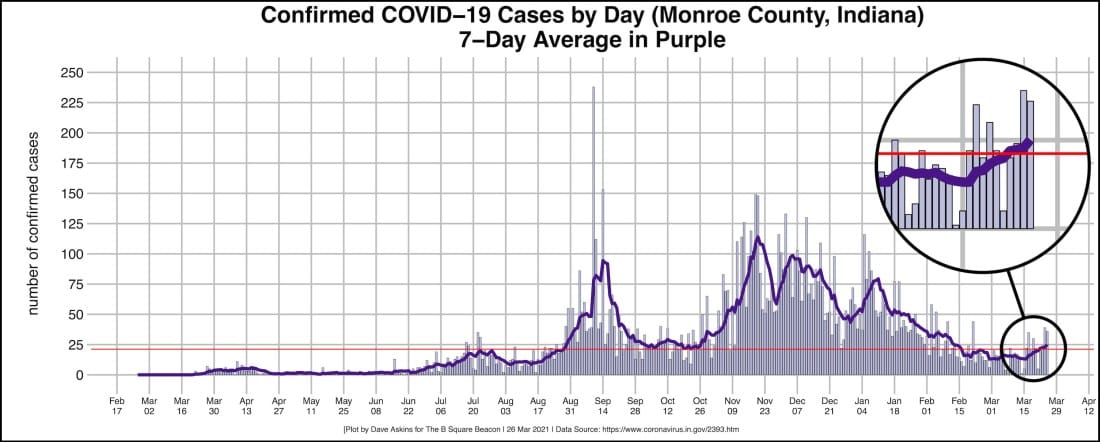Upward nudge in Monroe County COVID-19 case numbers means local health regs likely to stay in place, after governor’s April 6 end date


Indiana governor Eric Holcomb announced Tuesday an end to statewide COVID-19 restrictions, starting April 6.
But Monroe County health administrator Penny Caudill said on Friday that Monroe County’s regulations will remain in place for the time being.
That’s based in part on a recent uptick in positive cases in the county, which includes Indiana University’s campus.
Caudill was speaking at the weekly Friday news conference held by local officials on COVID-19 response.
Under the county board of health’s current health order, Caudill and county health officer Thomas Sharp have the “the ability to adjust restrictions—in any particular area—as required, in order to protect the public health.”
The county board of health is next scheduled to meet on April 6 at 4 p.m. Caudill said the board routinely looks at the pandemic data to make changes and adapt as numbers improve.
The restrictions that will remain in effect for Monroe County include: masking requirements; a prohibition against bar top service (customers in restaurants have to be seated at a table); six-foot physical distancing; and gathering size limits.
Monroe County’s gathering size limit, which is applicable to all commercial and non-commercial gathering or events, is 50 people. The city of Bloomington, which operates under a more restrictive order from mayor John Hamilton, has a gathering size limit of 15 people.
At Friday’s news conference, Hamilton said: “It is not time to relax our guard. It is not time to declare victory. It is time to stay the course and monitor very carefully what is happening.”
Even though Hamilton’s message on Friday continued to be cautious, he reported a significant milestone: For the last four weeks, no new COVID-19 cases had been found among the city of Bloomington’s 850 employees.
About the recent uptick in numbers Hamilton said, “None of this calamitous, but not the direction we want in some of those numbers.”
Kirk White, who’s Indiana University’s assistant vice president for strategic partnerships, reported on Friday the results of the mitigation testing that the university is doing, which includes around 21,000 tests a week. Last week, the positivity rate had bumped up from a 0.3 to 0.4 percent, he said.
Caudill said she did not think the uptick in the county was necessarily related to spring break travel. “I really think it is people in many ways being tired. I think that they are just relaxing a little too much, too quick,” Caudill said.
Caudill said an impact from spring break travel might yet be seen. “It’s going to be another week, maybe two weeks before we really see the effects of those people that may [have traveled on spring break].”
What are the actual countywide confirmed positive numbers in recent weeks?
The countywide case numbers show a 7-day rolling average that has now crept above 21.2 cases a day. Friday’s state dashboard number put Monroe County’s 7-day rolling average at about 25.
More than an average of 21.2 daily cases would mean more than 100 cases per 100,000. That would put Monroe County into the “orange” category on the per-capita metric used by the state. Even when combined with Monroe County’s best-possible score on positivity, an “orange” rating for cases per 100,000 would put Monroe County into the “yellow” category overall.
Friday’s state dashboard report showed 36 cases for Monroe County.
On Tuesday, Holcomb announced that the regulations tied to the color-scheme will end April 6. But the state health department will continue to calculate the metrics for the color codes, so that local officials can use that information for their decisions about regulations.
As Holcomb put it on Tuesday, decisions on restrictions to contain the spread of the pandemic virus now “will be in the hands of local officials.”
About the softening of the statewide mask mandate to an “advisory,” Holcomb said, “As always, local governments, businesses and other entities may impose more stringent guidelines, such as choosing to keep mask wearing mandatory in their facilities.”
Holcomb added, “So whether that is a bank branch lobby, on the factory floor, or a county courthouse, or city hall, they retain the authority to make decisions about COVID restrictions for their operations and should be afforded their respect, compliance and understanding of all who visit them.”
About his own approach, the governor said, “When I visit my favorite restaurants or conduct a public event, I will continue to appropriately wear a mask. It’s the right thing to do.”




Comments ()